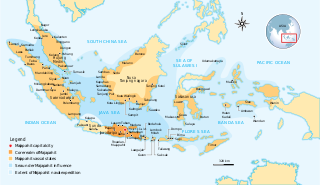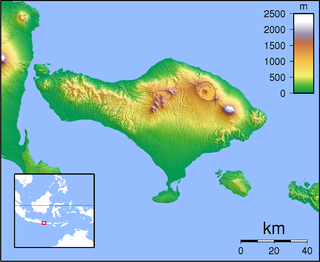Related Research Articles

Majapahit, also known as Wilwatikta, was a Javanese Hindu-Buddhist thalassocratic empire in Southeast Asia that was based on the island of Java. It existed from 1292 to c. 1527 and reached its peak during the era of the queen Tribhuvana and her son Hayam Wuruk, whose reigns in the mid-14th century were marked by conquests that extended throughout Southeast Asia. This achievement is also credited to the famous prime minister Gajah Mada. According to the Deśavarṇana written in 1365, Majapahit was an empire of 98 tributaries, stretching from Sumatra to New Guinea; including territories in present-day Indonesia, Singapore, Malaysia, Brunei, southern Thailand, Timor Leste, southwestern Philippines although the scope of Majapahit sphere of influence is still the subject of debate among historians. The nature of Majapahit's relations and influence upon its overseas vassals and also its status as an empire still provokes discussion.

East Java is a province of Indonesia located in the easternmost third of Java island. It has a land border only with the province of Central Java to the west; the Java Sea and the Indian Ocean border its northern and southern coasts, respectively, while the narrow Bali Strait to the east separates Java from Bali by around 2.29 kilometres (1.42 mi). Located in eastern Java, the province also includes the island of Madura, as well as the Kangean islands and other smaller island groups located further east and the Masalembu archipelago to the north. Its capital is Surabaya, the second largest city in Indonesia, a major industrial center and also a major business center. Banyuwangi is the largest regency in East Java and the largest on the island of Java.

Nusantara is the Indonesian name of Maritime Southeast Asia. It is an Old Javanese term that literally means "outer islands". In Indonesia, it is generally taken to mean the Indonesian Archipelago. Outside of Indonesia, the term has been adopted to refer to the Malay Archipelago.

The history of the arrival of Islam in Indonesia is somewhat unclear. One theory states that Islam arrived directly from Arabia as early as the 9th century, during the time of the Umayyad and Abbasid caliphates. Another theory credits Sufi travelers for bringing Islam in the 12th or 13th century, either from Gujarat in India or from Persia. Before the archipelago's conversion to Islam, the predominant religions in Indonesia were Hinduism and Buddhism.
Gelgel is a village (desa) in the regency (kabupaten) of Klungkung, on Bali, Indonesia. The village, near the coast four kilometers south of the regency capital Semarapura, contains some structures of cultural interest and is known for its pottery and handwoven ceremonial songket cloth.

The History of Bali covers a period from the Paleolithic to the present, and is characterized by migrations of people and cultures from other parts of Asia. In the 16th century, the history of Bali started to be marked by Western influence with the arrival of Europeans, to become, after a long and difficult colonial period under the Dutch, an example of the preservation of traditional cultures and a key tourist destination.

Dalem Baturenggong, also called Waturenggong or Enggong, was a King (Dalem) of Bali who is believed to have reigned in the mid 16th century. He is in particular associated with the golden age of the Balinese kingdom of Gelgel, with political expansion and cultural and religious renovation. In Balinese historiography he represented an epic vision of kingship that served as a model for later rulers on the island.

Sri Aji Kresna Kepakisan was a king of Bali who governed the island under the suzerainty of the Javanese Majapahit Empire. He is supposed to have ruled in the mid-14th century, and to be the ancestor of the later kings of Bali. His historicity is, however, not clearly documented.

Dalem Segening was a king of Bali who reigned in the first half of the 17th century, his exact dating being still uncertain. He belonged to a dynasty which originated from Majapahit on Java, and ruled from the palace (puri) of Gelgel.

Dalem Di Made was a king of Bali who may have reigned in the period 1623–1642. He belonged to a dynasty that claimed descent from the Majapahit Empire of Java, and kept residence in Gelgel, close to Bali's south coast.
Dewa Pacekan was a prince on the Island of Bali, who possibly ruled the island kingdom for a short time, in 1642–1650. He belonged to a dynasty stemming from the Majapahit Empire of Java, which had its palace (puri) in Gelgel, near Bali's south coast. According to Balinese historiography he was the second son of king Dalem Di Made, who may have died in 1642. In Dutch sources from the 1630s, he appears to be mentioned as 'Patiekan' or 'Paadjakan', son of the current ruler. In the religious text Rajapurana Besakih, he is listed as the last deified ancestor of the Gelgel dynasty. He may therefore have succeeded Dalem Di Made, although later Balinese historical texts do not actually mention him as ruler in his own right. One text mentions that he directed his troops against the army of the Javanese Muslim Mataram kingdom in 1646. This confrontation is also described in Dutch and Javanese sources. His death is placed by Balinese texts in 1650. Dutch sources relate that the Dutch East Indies Company sent an embassy to Bali in 1651, but found on arrival that the unnamed king had recently died, and that chaotic internecine wars raged on the island.

The Kingdomship of Bali was a series of Hindu-Buddhist kingdoms that once ruled some parts of the volcanic island of Bali, in Lesser Sunda Islands, Indonesia. With a history of native Balinese kingship spanning from the early 10th to early 20th centuries, Balinese kingdoms demonstrated sophisticated Balinese court culture where native elements of spirit and ancestral reverence combined with Hindu influences—adopted from India through ancient Java intermediary—flourished, enriched and shaped Balinese culture.

Wapauwe Old Mosque is a historic mosque in Kaitetu village, located in the Wawane Mountains on the north part of cape Keitetu, Maluku, Indonesia. Established in 1414, it is the oldest mosque in the Moluccas and possibly the oldest mosque in Indonesia which has been maintained in its original state.

Islam is the most common religion in the Indonesian province of East Java, embraced by 96.7% of the whole population. Throughout its history, East Java has been considered one of the heartlands of Islam in Indonesia; the province experienced one of the earliest proliferations of Islam, as well as the establishment of the largest Islamic mass organization in Indonesia, Nahdlatul Ulama.

The Kingdom of Kaimana or Kingdom of Sran is one of the oldest Muslim kingdoms in West Papua, Indonesia. The kingdom was established by Imaga, with the title Rat Sran Nati Pattimuni, traditionally in 1309.

H. Bambang Santoso, S.Pd.I, M.A or known as Haji Bambang Santoso is a Senator of Indonesia, a Balinese Muslim community leader and an entrepreneur who has long been involved in various organizations and non-governmental organizations from regional to national degree. Santoso has been named the first Muslim representative in history to sit on the seat of the Regional Representative Council of the Republic of Indonesia representing Bali Province for the 2019–2024 period.

Al-Hilal Mosque or Al Hilal Old Mosque of Katangka, better known as Katangka Mosque, is a historical mosque in South Sulawesi, Indonesia. Constructed in 1603 by the first Muslim ruler of the Sultanate of Gowa, Sultan Alauddin, the mosque is considered the oldest mosque in South Sulawesi.
The Nurul Hilal Dato Tiro Mosque, formerly known as Hila-Hila Mosque, is a historical mosque in South Sulawesi, Indonesia. Constructed in 1605, the mosque is one of the oldest mosques in the archipelago.
References
- 1 2 3 4 5 Ini Masjid Tertua di Bali, yang Berada di Tengah Kampung Muslim. Tempo. Retrieved April 5, 2021.
- ↑ Mosque in Bali is potential as tourist destination. Republika. Retrieved April 5, 2021.
- 1 2 Gelgel. Lonely Planet. Retrieved April 5, 2021.
- 1 2 Masjid Tertua di Bali yang 'Selemparan Batu' dengan Pura. CNN Indonesia. Retrieved April 5, 2021.









